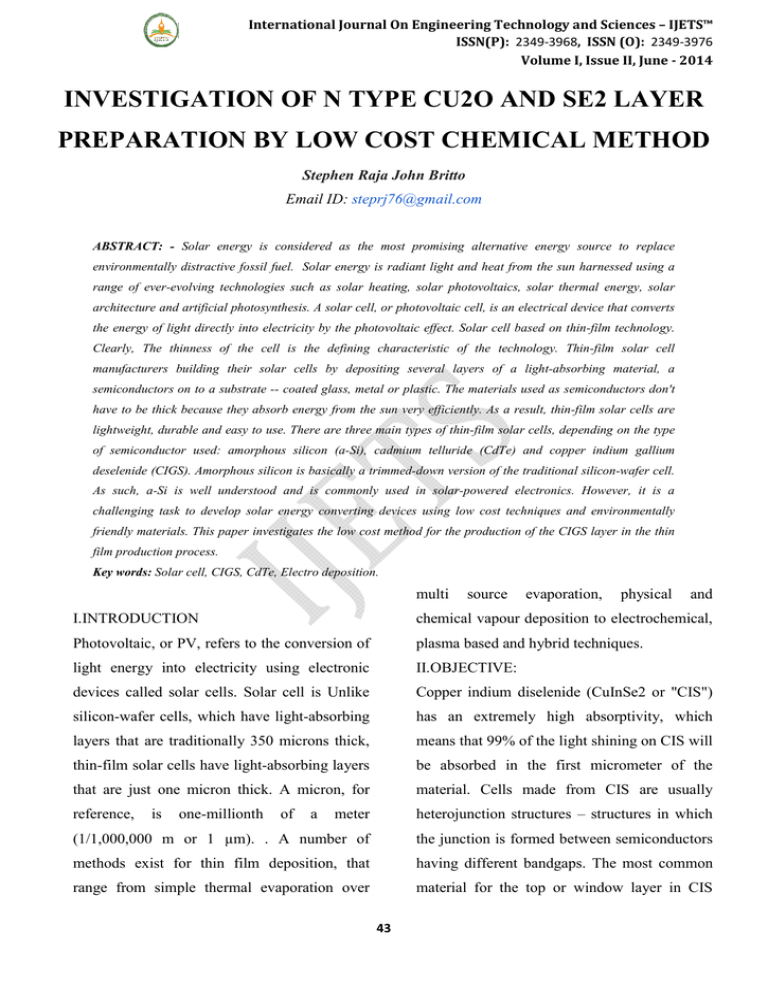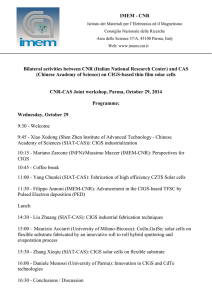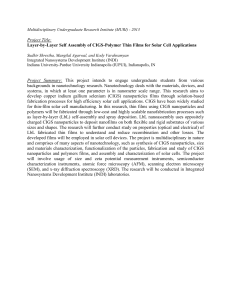investigation of n type cu2o and se2 layer preparation by low
advertisement

International Journal On Engineering Technology and Sciences – IJETS™ ISSN(P): 2349-3968, ISSN (O): 2349-3976 Volume I, Issue II, June - 2014 INVESTIGATION OF N TYPE CU2O AND SE2 LAYER PREPARATION BY LOW COST CHEMICAL METHOD Stephen Raja John Britto Email ID: steprj76@gmail.com ABSTRACT: - Solar energy is considered as the most promising alternative energy source to replace environmentally distractive fossil fuel. Solar energy is radiant light and heat from the sun harnessed using a range of ever-evolving technologies such as solar heating, solar photovoltaics, solar thermal energy, solar architecture and artificial photosynthesis. A solar cell, or photovoltaic cell, is an electrical device that converts the energy of light directly into electricity by the photovoltaic effect. Solar cell based on thin-film technology. Clearly, The thinness of the cell is the defining characteristic of the technology. Thin-film solar cell manufacturers building their solar cells by depositing several layers of a light-absorbing material, a semiconductors on to a substrate -- coated glass, metal or plastic. The materials used as semiconductors don't have to be thick because they absorb energy from the sun very efficiently. As a result, thin-film solar cells are lightweight, durable and easy to use. There are three main types of thin-film solar cells, depending on the type of semiconductor used: amorphous silicon (a-Si), cadmium telluride (CdTe) and copper indium gallium deselenide (CIGS). Amorphous silicon is basically a trimmed-down version of the traditional silicon-wafer cell. As such, a-Si is well understood and is commonly used in solar-powered electronics. However, it is a challenging task to develop solar energy converting devices using low cost techniques and environmentally friendly materials. This paper investigates the low cost method for the production of the CIGS layer in the thin film production process. Key words: Solar cell, CIGS, CdTe, Electro deposition. multi source evaporation, physical and I.INTRODUCTION chemical vapour deposition to electrochemical, Photovoltaic, or PV, refers to the conversion of plasma based and hybrid techniques. light energy into electricity using electronic II.OBJECTIVE: devices called solar cells. Solar cell is Unlike Copper indium diselenide (CuInSe2 or "CIS") silicon-wafer cells, which have light-absorbing has an extremely high absorptivity, which layers that are traditionally 350 microns thick, means that 99% of the light shining on CIS will thin-film solar cells have light-absorbing layers be absorbed in the first micrometer of the that are just one micron thick. A micron, for material. Cells made from CIS are usually reference, meter heterojunction structures – structures in which (1/1,000,000 m or 1 µm). . A number of the junction is formed between semiconductors methods exist for thin film deposition, that having different bandgaps. The most common range from simple thermal evaporation over material for the top or window layer in CIS is one-millionth of a 43 International Journal On Engineering Technology and Sciences – IJETS™ ISSN(P): 2349-3968, ISSN (O): 2349-3976 Volume I, Issue II, June - 2014 devices is cadmium sulfide (CdS), although a-Si is deposited followed by P2 laser scribing. zinc Then a metal conductive layer is placed as back is sometimes added to improve transparency. Adding small amounts of gallium contact with the relative P3 laser scribing. to the lower absorbing CIS layer boosts its bandgap from its normal 1.0 electron-volts (eV), which improves the voltage and therefore the efficiency of the device. This particular variation is commonly called a copper indium gallium diselenide or "CIGS" PV cell. Solar Figure 3.1Amorphous silicon (a-Si) cells based on these materials are also very 3.2 CIGS/ CIS: it is the semiconductor material stable, thus allowing long operational lifetimes. composed of copper, indium, selenium, and/or The preparation of a thin film solar cell is a gallium. In thin film technology, CIGS has the multistage process where every step affects the highest PV conversion efficiency. CIGS/CIS resulting cell performance and the production has similar manufacturing process as a-Si thin cost. CuInSe2 and other Cu chalcopyrites can films. However, as opposed to a-Si thin film, be prepared by a variety of methods, ranging the glass substrate on CIGS/CIS is at the rear from physical vapor deposition methods such instead of the front. In addition, Cds is applied as as a buffer layer. evaporation and sputtering to low- temperature liquid phase methods such as electro deposition. III. Different types materials used in thin films are amorphous silicon (a-Si), CIGS/CIS and CdTe. 3.1 Amorphous silicon (a-Si): most common and developed. It is the non-crystalline form of silicon. The cell structure has a single sequence of p-i-n layers. When exposed to sun, their power output is significantly decreased. A-Si type thin film solar cells are commonly found in calculators. A-Si type thin film Figure 3.2 CIGS (Copper indium gallium (di) is selenide) manufactured in 6 steps. First the glass 3.3 CdTe: it is formed from cadmium and substrate is coated with a TCO (transparent tellurium. It is usually combined together with conductive oxide) layer as front contact, cadmium sulfide to form a p-n junction PV followed by P1 laser scribing. Then a layer of cell. the composition is similar to a-Si solar cell 44 International Journal On Engineering Technology and Sciences – IJETS™ ISSN(P): 2349-3968, ISSN (O): 2349-3976 Volume I, Issue II, June - 2014 with an additional Cds layer for buffer. First Solar is the largest manufacturer. IV.CIGS (Copper indium gallium (di) selenide)has an extremely high absorptivity, which means that 99% of the light shining on CIGS will be absorbed in the first micrometer of the material. Figure 4.1 CIGS unit cell Red = Cu, yellow = CIGS (Copper indium gallium (di) selenide) CIGS is a I-III-VI2 semiconductor material Se, blue = In/Ga composed of copper, indium, gallium, and CIGS is a tetrahedrally bonded semiconductor, selenium. The material is a solid solution of with the chalcopyrite crystal structure. Upon copper indium selenide (often abbreviated heating it transforms to the zinc blende form "CIS") and copper gallium selenide. It has a and the transition temperature decreases from chemical formula of CuInx Ga(1-x)Se2 CIGS 1045 °C for x=0 to 805 °C for x=1. They are is a tetrahedrally bonded semiconductor, with manufactured by depositing a thin layer of the chalcopyrite crystal structure, and a copper, indium, gallium and abandgap varying continuously with x from selenide on glass or plastic backing, along with about 1.0eV (for copper indium selenide) to electrodes on the front and back to collect current. Because the material has a high CAS number 12018-95-0(CuInSe2) Molecular CuInxGa(1-x)Se2 absorption coefficient and strongly absorbs sunlight, a much thinner film is required than formula of other semiconductor materials. Density ~5.7 g/cm3 Melting point 1070-990 °C(x=0–1) coefficient of more than 105/cm for 1.5eV and Band gap 1.7–1.0 eV (x=0–1) higher energy photons. CIGS solar cells with Crystal tetragonal efficiencies around 20% have been claimed by CIGS has an exceptionally high absorption structure both Space group I42d Lattice a = 0.56–0.58 constant 1),c = 1.10–1.15 nm (x=0–1) the National Renewable Energy Laboratory (NREL) and the Zentrum für nm (x=0– Sonnenenergie und Wasserstoff Forschung (ZSW), which is the record to date for any thin about 1.7eV (for copper gallium selenide). film solar cell. 4.2 STRUCTURE Table 4.2 Properties of CIGS 45 International Journal On Engineering Technology and Sciences – IJETS™ ISSN(P): 2349-3968, ISSN (O): 2349-3976 Volume I, Issue II, June - 2014 IV.THIN FILM DEPOSITION METHODS which improves the voltage and therefore the Evaporation efficiency of the device. This particular Thermal evaporation variation is commonly called a copper indium E-beam evaporation gallium diselenide or "CIGS" solar cell. Sputtering So far the promise of CIGS solar cell DC Sputtering technology has been greater than the reality, DC Magnetron sputtering but certain advantages of this technology are RF sputtering beginning to emerge, namely: Chemical vapour deposition •The active layer (CIGS) can be deposited in a Low-pressure CVD polycrystalline form directly onto molybdenum Plasma-Enhanced CVD coated glass sheets or steel bands. This uses Metal-organic CVD less energy than growing large crystals, which is a necessary step in the manufacture of crystalline silicon solar cells. Also unlike 4.1 Advantages of CIGS in the photo voltaic crystalline silicon, these substrates can be cells: flexible. In thin film technology, CIGS has the highest •One environmental advantage of CIGS solar PV conversion efficiency. CIGS/CIS has cell technologies have over Cadmium Telluride similar manufacturing process as a-Si thin solar cell panels is that it uses a much lower films. However, as opposed to a-Si thin film, level of cadmium, in the form of cadmium the glass substrate on CIGS/CIS is at the rear sulfide. In some designs, sometimes zinc is instead of the front. In addition, Cds is applied used instead of cadmium sulfide all together. as a buffer layer. 99% of the light shining on a •Like Cadmium Telluride panels, CIGS solar CIGS solar cell will be absorbed in the first cell panels show a better resistance to heat than micrometer of the material. Cells made from silicon based solar panels. CIGS are usually hetero-junction structures— 4.2 Electro deposition of CIGS layer structures in which the junction is formed between semiconductors having Efficient CIGS solar cells prepared directly different from bandgaps. The most common material for the electrodeposited near stoichiometric precursor films without the post PVD process top or window layer in CIS devices is cadmium were reported by several research groups. sulfide (CdS), although zinc is sometimes Lincot et al. reported an efficiency of 11.3% added to improve transparency.Adding small (Jsc= 23.2mA/cm2, Voc= 0.77 V, FF = 63.4%) amounts of gallium to the lower absorbing CIS for an electrodeposited CIGS absorber with a layer boosts its bandgap from its normal 1.0eV, band gap of 1.47 eV. Guimard et al. recorded a 46 International Journal On Engineering Technology and Sciences – IJETS™ ISSN(P): 2349-3968, ISSN (O): 2349-3976 Volume I, Issue II, June - 2014 cell efficiency of 10.2% without the PVD step. period, The cell parameters were Jsc= 23.2mA/cm2, demonstrated the capability of its electro Voc= deposition 0.74V and FF = 59.6%. the company process to developed yield and Cu-In-Ga-Se Electrodeposition of an elemental layer stack precursor layers with controlled and repeatable followed by the selenization treatment led to 7- Cu/(In+Ga) and Ga/(In+Ga) molar ratios. After 10% efficient devices. Ganchev et al. deposited roll-to-roll plating hardware to process a 13.5- the absorber film from a thiocynate assisted in.-wide web was installed, the capability of the bath, followed by selenization in a quartz tube tool to deposit films with uniform thickness furnace at 560oC under the Se pressure of was first demonstrated. Then the compositional 10mbar. However, the efficiency of the best control was shown through measurement of cell (Mo/CIGS/CdS/i-ZnO/Al : ZnO) was of electrodeposited Cu-In-Ga-Se precursor layers. only 4.35%, with Jsc= 31.7mA/cm2, Voc = 300 mV and FF = 45.6%. Dale et al. reported a cell efficiency of 4.5%. These reported works showed that the cell efficiency increased considerably as a result of the post vacuum deposition. This increase was Figure 4.2.1 R2R PECVD Process attributed to the near film stoichiometry and the resulting band gap. However stoichiometric One of the most important requirements for films prepared without the post vacuum successful application of an electro deposition deposition always showed lower efficiency. It technique to CIGS absorber formation is the can be noticed that the cells constructed with demonstration of the ability of the technique to the post vacuum deposited CIGS layer always control the composition of the deposited films showed higher FF values. in a reliable and repeatable manner. Figure This may be another reason for the obtained 4.2.1.a shows the Ga/(Ga+In) molar ratio data higher efficiency. The post-deposition may also collected from the electrodeposited layers by be beneficial in avoiding micro cracks and ICP measurements during a period of 95 days. defects in the film. However, it should be noted The target in this experiment was a molar ratio that the post PVD step is not acceptable in of 0.3 in the deposited film. The electrolyte and terms of cost factor. the process conditions were kept unchanged 4.2.1ROLL-TO-ROLL during the whole test period. ELECTRODEPOSITION The data of Figure 4.2.1.a demonstrate that the The electro deposition step is the heart of the electro deposition process of this work has the SoloPower technology. During this project 47 International Journal On Engineering Technology and Sciences – IJETS™ ISSN(P): 2349-3968, ISSN (O): 2349-3976 Volume I, Issue II, June - 2014 capability to include Ga in the deposited films in a reliable and repeatable manner. Figure 4.2.1.b shows the Cu/(Ga+In) molar ratio data collected from the same plated samples during the same 95-day period. The target ratio in this case was 0.8, and as can be seen from the data, this ratio was controlled between the values of Figure 4.2.1.b. The Cu/(Ga+In) molar ratio 0.76 and 0.84 as measured by ICP. This is data collected from samples electroplated within the accuracy band of the measurement during a period of 95 days. method, and therefore the results demonstrate a In addition to the repeatability and robustness good ability for the technique to control of the electro deposition process in terms of its composition. It should be noted that for the two compositional control, experiments were also excursion points in the data of Figure 4.2.1.b, carried out with the roll-to-roll electroplating the measurement instrument was found to be tool to demonstrate that the film thickness and faulty. The data of Figures 4.2.1.a and 4.2.1.b the stoichiometry were uniform throughout a were collected from the batch process line to large-area substrate. In one early experiment evaluate the behavior and stability of the during the Phase I program, a 13.5-in.-wide and plating results 400-ft-long foil substrate was continuously demonstrated, even for baths with limited processed through the roll-to-roll electroplating volume, the chemistry did not show any time- system and then the deposited film thickness, dependent instabilities. the Cu/(Ga+In) ratio, and the Ga/(Ga+In) molar baths. As the above ratio were measured across the 12.5-in.-wide section of the web as well as along the web, at 100-ft intervals. The thickness of the deposit was found to be within 10% of the target value. Figure 4.2.1.a. The Ga/(Ga+In) molar ratio data collected from samples electroplated during a period of 95 days. Experiment was Figure 4.2.1 c Back-contact resistivity carried out in the batch plater. for different types of contacts and the stability of the contact resistance at elevated temperature for up to 728 h. 48 International Journal On Engineering Technology and Sciences – IJETS™ ISSN(P): 2349-3968, ISSN (O): 2349-3976 Volume I, Issue II, June - 2014 ADVANTAGES: of Cu2O and application for solar cells. Sol. Energy, The system generates plasma between a pair of Vol. 80, 715-722 2.Anandan, S., Wen, X. & Yang, S. (2005). Room rollers connected to power supply. Since the temperature growth of CuO nanorod arrays on copper surface of the rollers is covered with the film and their application as a cathode in dye-sensitized solar substrate to be coated, the system does not have cells. Mater. Chem. Phys., Vol. 93, 35-40 powered electrodes to be contaminated with the 3. V. S. Arunachalam (Center for Study of Science, coating, and this results in stable process during India) and E. L. Fleischer (MRS) MRS Bulletin (2008). a long deposition process for a web.By using 4. M.A. Contreras, K. Ramanathan, J. AbuShama, F. HMDSO/O2 mixture as process gases, the Hasoon, D.L. Young, B. Egaas and R. Noufi, Prog. system is able to deposit SiOx coating as a Photovolt: Res. Appl. 2005; 13:209–216. deposition rate up to 900nm·m/min. 5.M. Contreras, M. Romero, B. To, F. Hasoon, R. Noufi, This mechanism gives the S. Ward and K. Ramanathan, “Optimization of CBD following CdS Process in High-Efficiency Cu(In,Ga)Se2-Based advantages Solar Cells,” Thin Solid Films, Vol. 403-404, No. 579, High material use efficiency 2002, pp. 204-211. High deposition rate 6. A. Davis, K. Vaccaro, H. Dauplaise, W. Waters and J. Low contamination Lorenzo, “Optimization of Chemical Bath-Deposited Cadmium Sulfide on InP Using a Novel Sulfur Pretreatment,” Journal of The Electrochemical Society, Vol. 7.6 CONCLUSION 146, No. 3, 1999, pp. 1046-1053. From the investigation of CIGS production, test 7.Fortin, E. & Masson, D. (1981). Photovoltaci effects in shows that the solar cells efficiency increases Cu2O-Cu cells growing by anodic oxidation. Solid-St. with increase in the source temperature, and Electron., Vol. 25, 4, 281-283 roll to roll electroplating process is the low cost 8.Garuthara, thin film W. (2006). type Cu2O films. J. Luminescence, Vol. 121, 173-178 9. Ghijsen, J., Tjeng, L.H., Elp, J. V., H. Eskes, deposition rate of the material is uniform in this Westerink, J., & Sawatzky, G.A. (1988). Electronic process structure of Cu2O and CuO. Phys. Rev., Vol. 38, 11322- the process. Siripala, The and production & Photoluminescence characterization of polycrystalline n- method for the production of the CIGS layer in the R. contamination in the 11330 production is very low when compared to other 10. Guy, A. C. (1972). Introduction to Material Science methods. Thus electroplating had given more (International Student Edition), McGraw-Hill, Tokyo advantages when compared with the other Hames,Y. & San, methods. REFERENCES 1.Akimoto, K., Ishizuka, S., Yanagita, M., Nawa, Y., Goutam K. P. & Sakurai, T. (2006). Thin film deposition 49

